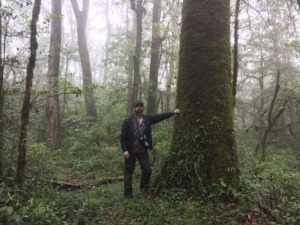Source: Discover Conservation
A wife and husband living in the wild and remote Sierra Gorda mountains in Central Mexico decided to make a stand against the region’s environmental destruction. They created a grassroots environmental movement, gaining the support of their neighbours, even though they depended on logging the forest to make a living. Roberto, one of their sons, explains how conservation is making financial sense for these poor communities… 
Can you tell us how you first got involved in conservation?
I grew up in the Sierra Gorda mountains and when I was a kid we had a simply life, raising horses and cows. Then my parents started getting involved in conservation activities, as the Sierra Gorda was a real mess. Back then, no one was taking care of these mountains, of the ecosystems and the wildlife. There was logging everywhere. There was poaching everywhere. The rivers were getting polluted with sewage from the small towns. Roads were being built into the forest. So my parents began with environmental education, since my mother used to be a teacher when we lived in the city. My father sold our cattle and began to plant trees in our own property. This set an example and the neighbours became interested. Over time, a grassroots movement to protect the Sierra Gorda began to grow. My parents founded Grupo Ecológico Sierra Gorda in 1989. After several years of work, they collaborated with the federal government to create the Sierra Gorda Biosphere Reserve. Since I was 12 years old, I’ve been involved in the activities of the NGO that my parents founded. I grew up doing it, so it was quite natural to carry on taking care of the land and the biodiversity of these mountains. Ever since I was a kid, I’ve been badly affected by Biophilia – a concept that was invented by Edward Wilson, a famous US biologist, to describe people who have deep affiliations with nature and how this is rooted in our biology. I have always felt this need to take care of nature’s creatures.
Tell us a bit about the ecosystems that you’re protecting?
The Sierra Gorda is one of the most ecologically diverse protected areas in Mexico. Remember that Mexico is one of the top 10 mega diverse countries in the world. So it really is a very special tract of this country. In the Sierra Gorda you will find one of the oldest deserts in Mexico, 65 million years old. Because of its age, it has a number of endemic and endangered species. Then we have the temperate forests, with douglas firs and aspens, from the Arctic influence – they are northern migrants from the glaciations. Moving up to higher elevations we have the cloud forests, one of the richest ecosystems in Mexico because of the diversity of species in very small areas. About the wildlife; we have 110 mammal species and all of the 6 species of cat found in Mexico – from the jaguar to the lynx. There are 339 bird species and almost 100 of them are neo-tropical migrants; they are US and Canadian tourists that come to spend their winters here, before going back north to have their babies. We have 2,300 plant species, with new discoveries coming from the field all the time. It’s incredible the amount of diversity that’s hidden here and nobody knows what we have.
How does Grupo Ecológico Sierra Gorda work to protect the region?
No one is making a special effort to protect this biodiversity. So we create private protected areas, with the support of our partners the World Land Trust and IUCN-NL, to save rare and endangered plants and creatures. But a lot of the work in the Sierra Gorda involves collaborating with the local people, because they are the owners of the diversity. It’s the same across Mexico and many places within Latin America, but often conservationists don’t realise that they must work with local people. Conservation organisations have to offer economic alternatives to locals, so that they protect the forest. If not, they will chop it down because they have to make a living. It’s so clear, logical and simple. The root of the problem is that poor people don’t have any alternative. So you need to pay them for the services that their forest provides. A lot of people don’t like it, the idea of putting a price on nature. I don’t like it either really, but if you are practical – if you work in the field and see how things happen – then it really does make a lot of sense. Most people in the Sierra Gorda are very poor, so giving them payments for the water, biodiversity or carbon within their forest means they have a bigger income than before. We combine this with creating alternative livelihoods within ecotourism, reforestation, soil restoration and ecological livestock management. In the Sierra Gorda, conservation is now a better business than cattle ranching or agriculture.
What’s your job like day-to-day?
I have to spend some days at the desk, mostly writing funding proposals and articles. But I am very fortunate that part of my time is dedicated to working in the field, mostly surveying the network of private nature reserves we manage, some of the wildest and remotest sites left in the sierra. A lot of this field work involves wandering around the forest trying to photograph really rare and endangered species. What I like most about this work is that it really makes a difference. I could go to Antarctica and photograph penguins, but a bunch of really great photographers have been there before. I could take more pictures of penguins, but so what? It makes no difference and there is a lot of carbon involved in the travelling. But if I keep looking for new species around here, that nobody has photographed before, then I can make a difference. It’s strange, I feel like I have a special antenna that tells me what’s different within the forest. I often sense that a plant is strange and looks out of place. Then, when I send my photos of it to the experts, it turns out to be a new species. These discoveries are often more endangered than pandas or Bengal tigers, because they are found only on one specific slope of a particular mountain and nowhere else in the world. Of course, they are not as iconic as a panda but they are much more rare and endangered.
What are the highlights of your work?
We’re directly protecting endangered species. My main concern in this life is climate change and the sixth wave of extinction, because it’s happening so fast. We have about 150 to 200 species going extinct on a daily basis. So I’m often wondering how long ecosystems are going to sustain themselves. I think of an ecosystem like a house; if you keep on taking bricks out, how long will it be before the house collapses? It could be jaguar or a salamander that you take away, but you don’t know what special job that creature was doing. So when I go out into the field and see that through our work we are able to stop logging and poaching, that’s the greatest highlight. By involving the community we are taking the pressure off the forest in a way that’s also alleviating poverty. It really makes sense.
What’s the hardest part of your job?
Fundraising, whether it’s for the NGO or for myself as a photographer, it always the hardest thing to do. If I was just making a living from wildlife photography, I’d be starving for sure. It’s quite under appreciated. People always want photos for free and they think that they are giving you visibility, but you have to make a living too. Wildlife never cooperates with you either, so you really have to work hard! You have to be there at sunrise and sunset, when you have decent light to shoot landscape photography. You have to deal with the heat, the ticks, and the rain. You need expensive gear. So it’s quite a hardship! But through my photography I can make a difference; my images have become a very good tool for the NGO. We have been using them in a number of ways, from advertising Sierra Gorda in Mexico City airport, to using them in educational materials, or publishing them in books and magazine articles, like the National Geographic en Español. But most of all I love using my photos in the talks I give. When kids come from city schools, I show them 100 photos of Sierra Gorda and tell them the stories behind the photos. As I tell these stories, I watch their shocked faces. They had no idea we have all these creatures in these forests. So I really enjoy giving those talks.
Are you optimistic about the future for conserving biodiversity?
We are very short of time. Human population keeps booming and we are releasing huge amounts of carbon. We should keep doing our best and keep acting in solidarity with wildlife. But if you start thinking about how most people are behaving and how little they care about nature, they don’t even see that it’s for our own well being, then it’s hard to be optimistic. But anyway, we know we are doing the right thing. If more people start supporting us or fighting their own environmental battles, then we could make a difference. Then we could still have time.
Do you have any advice for people looking for a career in conservation?
Young people should get involved in real conservation NGOs. Not the conversation ones. Many of them are just chatting about the issues. They are taking resources that should be used in the field and they are using them to chat and publish papers. I’m not against publishing scientific papers but it’s the role of institutions, like universities. It’s a very important one and we need that research made available. But it’s not the job of conservation NGOs, it’s a distraction. If they’re into photography, then think about how it can make a difference. I know the difference that my photography has made to this area. So they should get involved with a conservation NGO and that way their photography can be really useful. It then becomes more than just nice photos, instead they can be used to teach and raise awareness. They should focus on capturing images of species and ecosystems that are under photographed. Choose a place where no photographer has been before. It doesn’t make sense to shoot giraffes or lions, as there are already so many good photographs of that. What’s the point in adding to the collection? Focus on really endangered, new, or endemic species. That makes a difference. In whatever area you decide to work, keep common sense in the way you act. Don’t get distracted. There are many ways to get distracted. You may be tempted to choose a route that is easy and nice, but you should keep focused. What is it that you really want to achieve? I think that’s it, it’s all the wisdom I have!

